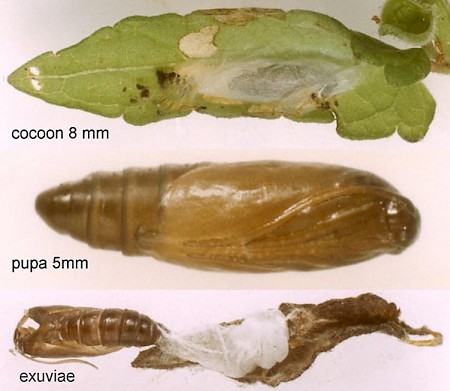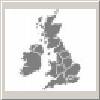
48.002 BF388
Prochoreutis myllerana
(Fabricius, 1794)
Wingspan 10-14 mm.
P. myllerana is widespread in Britain and is sometimes locally common, resting on or flying over its foodplants (Scutellaria spp.), from May to early September.
The life cycle is probably in three overlapping generations, with ova, larvae, pupae and adults often all occurring at the same time.
Many old records are uncertain because it closely resembles Prochoreutis sehestediana, although there are subtle differences, mentioned under that species.
The larva lives at first under a web on a leaf and later in a rolled leaf. Larvae of the various generations probably feed in all months from April to early October. Those from late August ova grow to about 5 mm in the fourth instar in October and then cease feeding and growth, even if kept indoors in warmth. It is assumed winter diapause is passed at this stage, and that feeding is completed on new growth of the foodplants in the following April.
- Larva: (description Ian F. Smith):
Foodplants: The reddish orange ova are laid, sometimes two or three together, on leaves and stems of the foodplants; skullcap (Scutellaria galericulata) and Lesser skullcap (S. minor). Early instars singly 'window' a leaf under a sheet of fine web which, on occasion, has been mistaken for a mine. Frass accumulates on the web and eventually conceals the larva. As the larva grows, the silk draws up the edges of the leaf until they meet to form a silk and frass filled tube, which often flares open at the end.
First instar Length: Up to 1.5 mm, at which length it moults to second instar. (See newly moulted second instar on early habitation image.)
Second instar Length: 2 mm larva described. Head: Brown. Frons, and a transparent band bordering it on the capsule, paler. Dark brown epicranial and adfrontal sutures. Posterior thinly edged black. Black crescentic posterolateral mark. Stemmatal area black. Prothoracic shield: Translucent brown. Divided by pale median line. Thoracic legs: Translucent, tinted pale brown. Body: Translucent shagreened brownish white. Gut shows brown or dull yellowish green. Spiracles: Not discerned. Pinacula: Brownish. Dorsal pair on A9 conjoined and prominent. Setae: Transparent, slightly yellowish. Anal plate: Transparent shiny brownish. Shows black if frass in transit. Prolegs: Thin and elongate. Basal half as venter. Distal half colourless transparent. Crochets brown.
Third instar Length: 3 mm and 4.5 mm described Head: Translucent brown with darker blotches. Frons, and a broad transparent band bordering it on the capsule, straw-coloured. Dark brown epicranial and adfrontal sutures. Posterior thinly edged blackish. Black crescentic posterolateral mark. Stemmatal area black. Mouthparts reddish brown. Prothorax (T1): Large shiny brown trisetose prespiracular pinaculum and bisetose subventral pinaculum. Prothoracic shield shiny brown with lateral pit. Divided by wide yellowish medial line. Six setae along anterior and four on posterior , arising from pale setal spots. Thoracic legs: Transparent tinted reddish brown. Black lines at joints. Body: Translucent shagreened shiny greenish grey. Broad blackish grey gut visible. Contractile vessel shows as thin dark dorsal line on abdomen. Spiracles: Thin pale brown peritreme. Pinacula: Large, brownish black. Dorsal pair on A9 conjoined and prominent. Setae: Translucent brownish. Anal plate: Translucent brown, showing black when frass in transit. Prolegs: Thin elongate transparent colourless planta. Crochets insignificant, brown. Large brownish grey lateral sclerite on anal proleg.
Fourth instar Length: 5 mm described. Head: As third instar Prothorax (T1): As third instar, but with dark mark in lateral pit. Thoracic legs: Transparent, faintly tinted light brown. Blackish collar at base of femur. Base of legs as venter with brownish horseshoe collar. Body: Stouter outline and less translucent than third instar. Shagreened yellowish green. Greyish tint from gut, if occupied. Gut usually vacant from mid-October. Spiracles: As third instar Pinacula: Large, dark brown with fine black setal spot. Dorsal pair on A9 conjoined and prominent. Setae: Transparent, slightly tinted pale brown. Anal plate: Translucent brown. Prolegs: Thin elongate transparent planta, slightly tinted pale brown. Crochets insignificant, brown. Large brown lateral sclerite on anal proleg.
Final instar Length: 7.5 mm and 8.5 mm described Head: Translucent showing interior colour; apple green or greenish white. Posterior half of head blotched yellowish brown. Light brown epicranial and adfrontal sutures. Posterior thinly edged blackish. Black stelliform posterolateral mark. Stemmatal area black. Mouthparts reddish brown. Prothorax (T1): Brownish grey trisetose prespiracular pinaculum and bisetose subventral pinaculum. Prothoracic shield transparent showing interior colour; apple green or greenish white, with brownish grey mark in lateral pit. Six setae along anterior and four along posterior, arising from pale setal spots in brownish grey pinacula. Thoracic legs: Translucent, coloured as venter. Tarsus faintly tinted yellowish brown. Body: Translucent shagreened apple green or greenish white. Broad gut contents visible as grey shadow. Contractile vessel shows as thin dark dorsal line on abdomen. Spiracles: Small. White with very thin pale brown peritreme. Pinacula: Large, brownish grey with fine black setal spot. Dorsal pair on A9 conjoined, prominent, and transparent colourless, showing distinctly black when frass in transit. Setae: Transparent, slightly tinted brownish. Anal plate: Translucent showing body colour, or greyish black if frass in transit. Marked brownish around pinacula on periphery and medially. Prolegs: Thin elongate transparent planta, almost colourless. Crochets dark brown. Large brown lateral sclerite on anal proleg.
Similar species The larvae of P. myllerana and P. sehestediana have been frequently found together on the same plant. They have yet to be distinguished from each other, so they should be reared to imago for identification. An unidentified micro-moth larva has been found feeding in sewn leaves of skullcap in September. Its brown body and the puckered edge to the sewn leaf serve to distinguish it from P. myllerana. The striking and prominent larva of the sawfly Athalia scutellariae, black with white polka dots, is unlikely to be confused with P. myllerana, but it acts as quick confirmation that skullcap has been found.
Life cycle (provisional) The life history of P. myllerana in MBGBI 7-2 is incomplete, and the species account in MBGBI 2 says that that the overwintering stage is unknown. The following sequence is based on information in MBGBI supplemented by field and rearing observations. Timing of the stages may vary with weather and individual specimens. Continuing study may lead to revision. Jan.-Feb: Larva in diapause. March: Larva in diapause. (Recommences feeding late in month ??) April: Larva moults to final instar and completes feeding. April/May: Pupa May/June: Imago generation 1; Ovum June: Larva July: Pupa; Imago generation 2; Ovum July/Aug: Larva Aug: Pupa Aug./Sept: Imago generation 3; Ovum; Larva Sept.-Oct: Larva (Ceases feeding and growth at fourth instar during Oct.) Nov.-Dec: Larva in diapause.
Acknowledgement Thanks are due to Ben Smart, who showed me my first P. myllerana.(IFS)

 UKMoths
UKMoths 












